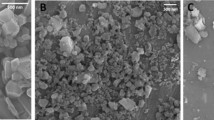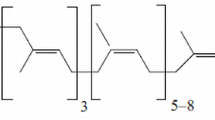Summary
9α-fluor-16α,17α-isopropyliden-dioxyprednisolon (FIDP) inhibits after dust irritation the emigration of macrophages into the alveolar space. The activity of the cells available to phagocytosis in the alveolar space has not been reduced. Also in experiments with isolated cells no inhibition of phagocytosis, induced by the action of FIDP, could be measured.
Culture cells altered strongly morphologically under the influence of micro-crystalline FIDP. Besides a marked epithelisation of spindle fibroblasts, large halos of granular plasma formed around the nuclei. Following, a strong vacuolisation of plasma could be observed. The morphological changes were reversible.
Lactic acid production in these cultures has been completely inhibited for some time. O2-consumption corresponded to the only feeble growth of these cultures. Metabolic depression was also reversible. As the metabolic and growth reduction produced by the solved glucocorticoid was retrograde after ablution while it continued under FIDP under the same test conditions up to 4 weeks, we assume a phagocytosis of the glucocorticoid crystals by the cells which maintain their activity in the phagocytes over a period of 4 weeks.
Tating this effect as example, there is to discuss whether the influence of glucocorticoids on the active inflammatory cells are based on the same metabolic changes as those we were able to measure in our cultures.
Zusammenfassung
9α-Fluor-16α, 17α-isopropyliden-dioxyprednisolon (FIDP) hemmt nach Staubreiz die Emigration von Makrophagen in den Alveolarraum. Die Aktivität der zur Phagocytose im Alveolarraum zur Verfügung stehenden Zellen ist nicht herabgesetzt. Auch bei Versuchen mit isolierten Zellen war keine durch FIDP bewirkte Phagocytosehemmung zu messen.
Kulturzellen veränderten sich morphologisch unter dem Einfluß von mikrokristallinem FIDP stark. Außer einer ausgeprägten Epithelisierung der spindligen Fibroblasten bildeten sich um die Kerne große Höfe gekörnten Plasmas. Anschließend war eine starke Vacuolisierung des Plasmas zu beobachten. Die morphologischen Veränderungen waren reversibel.
Die Milchsäureentstehung in diesen Kulturen war zeitweise total gehemmt. Der O2-Verbrauch entsprach dem nur geringfügigen Wachstum dieser Kulturen. Die Stoffwechseldepression war ebenfalls reversibel. Da die durch gelöstes Glucocorticoid hervorgerufene Stoffwechsel- und Wachstumsminderung nach Auswaschen rückläufig war, während sie bei gleichen Versuchsbedingungen unter FIDP bis zu 4 Wochen anhielt, nehmen wir eine Phagocytose der Glucocorticoidkristalle durch die Zellen an, die ihre Wirkung in den Phagocyten über 4 Wochen aufrechterhalten. Am Beispiel dieser Wirkung ist zu diskutieren, ob der Einfluß der Glucocorticoide auf die entzündungsaktiven Zellen auf den gleichen Stoffwechselveränderungen beruhen, wie wir sie in unseren Kulturen messen konnten.
Similar content being viewed by others
Literatur
Aujard, C., etE. Chany: Effet de l'hydrocortisone sur la morphologie et l'adhésivité mutuelle ou au verre de cellules en culture (souche KB). Exp. Cell. Res.44, 53–65 (1966).
Barber, M., andA. Delaunay: Effect of plasma cortisone freatet guinea-pigs on the growth of fibroblasts and macrophages in tissue cultures in vitro. J. Path. Bact.63, 549 (1951).
Beickert, A.: Die Glucocorticoid-Therapie innerer Erkrankungen, S. 56–69. Jena: Fischer 1964.
Bjoernboe, M.: The effect of cortisone and ACTH on the concentration of circulating antibody. J. exp. Med.93, 37 (1951).
Clawson, B. J., andS. F. Nerenberg: The effect of large doses of cortisone upon the ability of the reticuloendothelial cells to phagocytose streptococci. J. Lab. clin. Med.42, 746 (1953).
Dougherty, T. F., D. L. Berliner, andM. L. Berliner: Corticosteroidtissue interactions. Metabolism10, 966–989 (1961).
Dougherty, F., A. White, andH. Chase: Relationship of the effects of adrenal. Cortical secretion on lymphoid tissue and on antibody titer. Proc. Soc. exp. Biol. (N.Y.)56, 28–31 (1944).
Gell, P. G. H., andI. T. Huide: The effect of cortisone on makrophage activity in mice. Brit. J. exp. Path.32, 516 (1951).
Heller, J. H.: The effect of various steroids on the phagocytic activity of the R.E.S. Physiopathology of RES43 (1957).
Hellmann, B. H.: The effect of 11-dehydro-17 hydroxycorticosterone on the migration of macrophages in tissue cultures. Proc. Mayo Clin.20, 318 (1945).
Hirsch, J. G.: Adrenal steroids and infection: The effect of cortisons administration on polymorphonuclear leucocytic functions and on serum opsonins and bactericidius. J. clin. Invest.40, 794 (1961).
Moeschlin, S., W. Zurukzogen u.J. Crabe: Untersuchungen über den Einfluß von Cortison und ACTH auf die Phagocytose der Leukozyten und Makrophagen. Acta haemat. (Basel)9, 227–288 (1952).
Rasche, B., L.-D. Leder u.W. T. Ulmer: Zur Wirkung der Glucocorticoide auf permanente Fibroblastenkulturen bei Dauerbehandlung (Wachstum, Morphologie, Zellstoffwechsel). Z. ges. exp. Med.144, 322–334 (1967).
—,G. May u.W. T. Ulmer: Die Phagocytoseaktivität von permanenten Fibroblasten (Monocyten) und menschlichen Entzündungsmakrophagen unter der Wirkung von Glucocorticoiden. Z. ges. exp. Med.144, 335 (1967).
—, u.W. T. Ulmer: Die zelluläre Retention und der zelluläre Transport inhalierter Staubpartikel in Alveolarmakrophagen. Med. thorac.24, 227 (1967).
— —: Abhängigkeit der Stoffwechsel- und Wachstumsänderungen bei permanenten Fibroblastenzellen nach Glucocorticoidbehandlung von der Konzentration und der Expositionsdauer. Z. Zellforsch.84, 506 (1968).
Seifert, R., andH. Hilz: Selective and reversible inhibition of proliferation and influence on metabolic functions in L-cells by low cortisol concentrations. Acta endocr. (Kbh.)53, 189–204 (1966).
Studer, A.: Zur Frage der Angriffsorte von Compound E (Cortison). Z. ges. exp. Med.121, 287–418 (1953).
Ulmer, W. T., u.R. Nicolas: Langzeitbehandlung der chronisch obstruktiven Bronchitis mit Corticosteroiden. Dtsch. med. Wschr.91, 1861 (1966).
Wilbrandt, W.: Über die Wirkung von Corticosteroiden und anderen entzündungshemmenden Stoffen. Schweiz. med. Wschr.96, 1136–1144 (1966).
Wright, B. M.: New dust-feed mechanism. J. Sci. Instrum.27, 1 (1950).
Author information
Authors and Affiliations
Additional information
Kristallsuspension Triamcinolon-Acetonid „Squibb“, Volon® A 40 der Firma von Heyden AG, München.
Diese Forschung wurde mit der finanziellen Unterstützung der Europäischen Gemeinschaft für Kohle und Stahl, Hohe Behörde, Luxemburg, durchgeführt.
Rights and permissions
About this article
Cite this article
Rasche, B., Ulmer, W.T. Zur Wirkung des Glucocorticoids 9α-Fluor-16α, 17α-isopropyliden-dioxyprednisolon auf die Phagocytoseleistung von Alveolarmakrophagen in vivo und auf Wachstum, Stoffwechsel und Phagocytoseaktivität permanenter Fibroblastenkulturen. Z. Gesamte Exp. Med. 149, 316–332 (1969). https://doi.org/10.1007/BF02044581
Received:
Issue Date:
DOI: https://doi.org/10.1007/BF02044581




